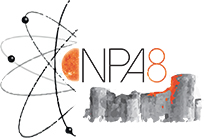Speaker
Dr
Vaclav Burjan
(Nuclear Physics Institute, CAS)
Description
Nuclear Physics in Astrophysics 8, NPA8: 18-23 June 2017, Catania, Italy
The direct 18O(p; °)19F capture and the ANC method.
V. Burjan1, Z. Hons1, V. Kroha1, J. Mr¶azek1, ·S. Pisko·r1, A. M. Mukhamedzhanov2,
L. Trache2, R. E. Tribble2, M. La Cognata3, L. Lamia3, G. R. Pizzone3, S. Romano3,
C. Spitaleri3 and A. Tumino3;4
1 Nuclear Physics Institute of Czech Academy of Sciences, 250 68 ·Re·z, Czech Republic
2 Cyclotron Institute, Texas A&M University, College Station, TX 77843
3 Universitµa di Catania and INFN Laboratori Nazionali del Sud, Catania, Italy
4 Universitµa degli Studi di Enna "KORE", Enna, Italy
Contact email: burjan@ujf.cas.cz
The depletion of 18O via the (p; °) capture is competing with the (p; ®) capture during the
CNO cycles in AGB stars. Despite the fact that the (p; ®) capture is dominant the (p; °) can
play an important role in mixing stages of star evolution. Here, we attempted to determine the
astrophysical S-factor of the direct part of the 18O(p; °)19F capture by the indirect method of
asymptotic normalization coe±cients (ANC). We measured the di®erential cross section of the
transfer reaction 18O(3He; d)19F at a 3He energy of 24.6 MeV. The measurement was realized
on the NPI cyclotron in ·Re·z, Czech Republic, with the gas target consisting of the high purity
18O (99.9 %). The reaction products were measured by eight ¢E-E telescopes composed from
thin and thick silicon surface-barrier detectors. The parameters of the optical model for the
input channel were deduced by means of the code ECIS and the analysis of transfer reactions
to 12 levels of the 19F nucleus up to 8.014 MeV was made by the code FRESCO. The deduced
ANCs were then used to specify the direct contribution to the 18O(p; °)19F capture process and
compared with two experimental works.
Author
Dr
Vaclav Burjan
(Nuclear Physics Institute, CAS)

